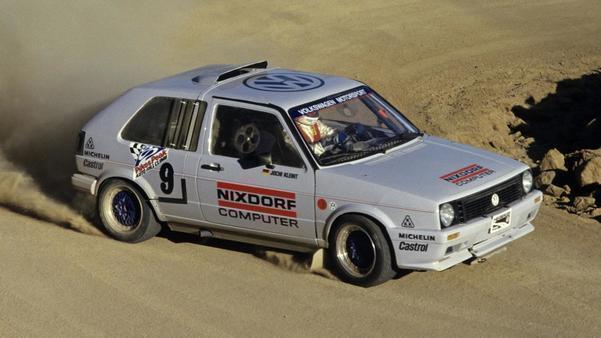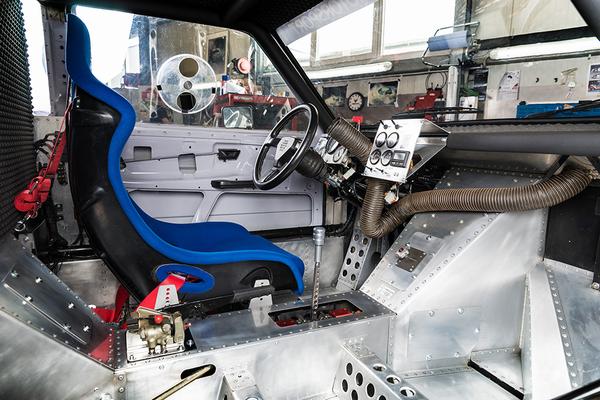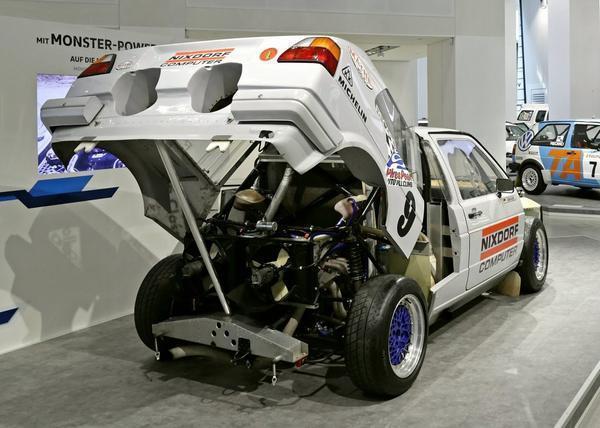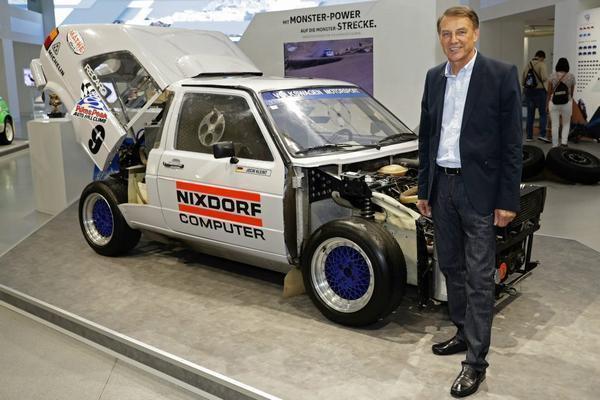How a Mk2 Golf very nearly conquered Pikes Peak
Klaus-Joachim 'Jochi' Kleint tells PH the backstory behind VW's 650hp twin-engine monster...

The Pikes Peak International Hill Climb course presents a unique, daunting challenge. Starting 2,862 metres above sea level, the 12.42-mile course twists and winds through 155 turns, climbing 1,440 metres at an average gradient of 7.2%, to the Colorado mountain's summit, some 4,300 metres above sea level.
When Volkswagen Motorsport's engineers looked at how to conquer the course, they quickly realised they needed a car developed specifically for the event. And their solution to Pikes Peak's challenges was bold, but simple: stick a motor at both ends of the car. So that's just what they did.
Except we're not talking about the twin electric motors of the ID R Pikes Peak that Romain Dumas will use to bid for the electric course record on Sunday June 24th, but the bonkers twin-engined Volkswagen Golf Mk2 Klaus-Joachim 'Jochi' Kleint used to contest Pikes Peak between 1985 and '87.
In the mid-1980s, Pikes Peak became a battleground for Group B rally cars, with manufacturers taking advantage of the liberal (well, largely non-existent) rule book for the event's Open class to make the already outlandishly powerful behemoths even crazier.
Back then, the Pikes Peak course was largely unpaved, making traction and power key. But producing that power was a major challenge at elevation: the lack of oxygen meant normal engines produced around 20% less power than usual at the start line, and nearly half at the summit.

Volkswagen didn't have a Group B car - the firm's rallying efforts were largely at European level with production-based Golfs - and knew it would need some extra push to stand a chance at Pikes Peak. The firm found the answer in a test vehicle developed by engineer Kurt Bergmann in 1981: a twin-engined Jetta dubbed the Twin Jet. That was followed by a twin-engined prototype Scirocco, before the first of the Pikes Peak Golfs was developed for 1985.
That first car featured two Oettinger-tuned 1.8-litre 16-valve engines. But without forced induction Kleint says they suffered a "dramatic" loss in performance in the final part of the course. He finished third, claiming rookie of the year honours, but some way behind Michele Mouton's Audi Sport Quattro S1.
The following year, Volkswagen fitted two turbocharged 1.3-litre Polo engines to the Golf, each producing 250hp. It was an improvement, but still not enough: Kleint was fourth.
For 1987, Volkswagen went all out. This time, Bergmann took two 1.8-litre 16v engines from the Golf GTI, and fitted both with turbochargers. Combined, the two motors could produce beyond 600hp.
The complex system meant Kleint's dashboard featured two sets of displays and controls for the two engines. Although they were synced up to be driven through one throttle and one gearbox, the car was capable of being driven by either engine or both, and in front-, rear- or all-wheel-drive guises.

The engines were sunk low in the front and back of the car and mounted longitudinally to improve balance and weight distribution. To offset the extra weight of the second engine, the Golf was built around a lightweight tubular frame, with the front and rear ends made of lightweight plastics. The result was a car that weighed 1,020kg. Add in that power, and the Golf could achieve 0-62mph in 3.4 seconds. This, remember, on a car that Kleint drove up a 155-turn, largely gravel course with few crash barriers and some very big drops over the side.
Sounds terrifying - but not to a rally driver. "No, it wasn't scary," laughs Kleint, now 70, with a glint in his eye. "It was absolute fun."
Kleint set his qualifying time with the car in single-engined mode, but would rely on both motors come the day of the event, decided then, as now, with a single run up the course.
The biggest challenge Volkswagen had with the car was keeping the engines in sync, ensuring a smooth delivery of all that power. "Wow, when the twin engines were in sync it was something different, I tell you," says Kleint. "In 1987 it was perfectly done. It didn't really feel like two engines. The car's balance was 50/50, too."
Of course, that's not to say the handling was perfect. Slap that much power into a lightweight Golf shell and stick it on gravel, and it's not exactly going to offer the smoothest ride.
"It was fine on the straight sections and fast bits, but when it got to the tight sections further up the hill, it would understeer a lot," recalls Kleint. Understeer, you can probably surmise, is less than ideal when you're approaching hairpins with drops of several thousand feet on the outside.

Still, Kleint found a way to cope. "I had to drive it in the same way I did the Ford Capri I used on the 1970 RAC Rally," he laughs. "You had to really work to get the tail out."
That year, Kleint's major rival was his friend Walter Rohrl, in a Quattro S1 that was extensively reworked from the now-banned rallying version. It was lighter, had more extreme aero and more power - around 610hp was Audi's official claim, although the true figure is believed to be around 760hp.
"To beat Walter, you had to be really on the ball," says Kleint, who rehearsed the course by recording all his pacenotes on a dictaphone, then listening to the recording repeatedly in the days leading up to the event.
Despite that, according to split times, Kleint was actually a few seconds faster than Rohrl at the halfway points of the run. It didn't last though: near the summit, a swivel joint cracked on the Golf, and he was forced to stop agonisingly within sight of the finish line.
Kleint knew little of the problem until shortly before he had to stop. "I didn't feel any issues on the fast sections of the course," he recalls. "That's probably just as well, because if I'd felt anything was wrong on those bits I'd probably have dropped my speed right down!
"It was right at the end that I felt it, The wheel on the inside just collapsed, and I couldn't continue. I could see the guy with the chequered flag, just two corners away. It was very frustrating."

That left Rohrl to take the victory in a time of 10m 48s - shattering the previous hill record by 22 seconds. And, remember, Kleint was apparently fastest to the halfway point...
Of course, the more technical higher portion of the course, where aerodynamics and power were more important, may well have favoured Rohrl. "I really don't know who'd have won," says Kleint. "You see Walter's car with the aero and my car... I don't know. The win was possible. But it wasn't to be."
It was there in 1987, two corners from the end, within sight of the finish, that Volkswagen's Pikes Peak efforts ended. At least until this year, with the ID R Pikes Peak.
Fittingly, it follows its predecessor with a twin motor layout, although that and the VW badge on the front are about the only similarities between the machines. With power loss at elevation not an issue for electric cars, the powertrain layout of Dumas' car is purely for weight distribution while, with the Pikes Peak course now entirely paved, the machine has more in common with a Le Mans prototype than a rally car.
Likely though, if you're the sort of person who enjoys driving up a mountain at speed, it'll still be "absolute fun" to drive.
James Attwood
"The biggest challenge Volkswagen had with the car was keeping the engines in sync, ensuring a smooth delivery of all that power." In terms of what? When boost kicked in? Even then it would probably be an advantage to have them out of sync to reduce lag and smooth power delivery.
"The biggest challenge Volkswagen had with the car was keeping the engines in sync, ensuring a smooth delivery of all that power." In terms of what? When boost kicked in? Even then it would probably be an advantage to have them out of sync to reduce lag and smooth power delivery.
The article should read "one throttle and one gear lever"
I've got photos of it during an earlier resto/maintenance regime at KWL Motorsport who look after a lot of the historic VWs.
Sadly they are hidden away somewhere in the photofarce website.
Epic car for it's time though

Gassing Station | General Gassing | Top of Page | What's New | My Stuff




